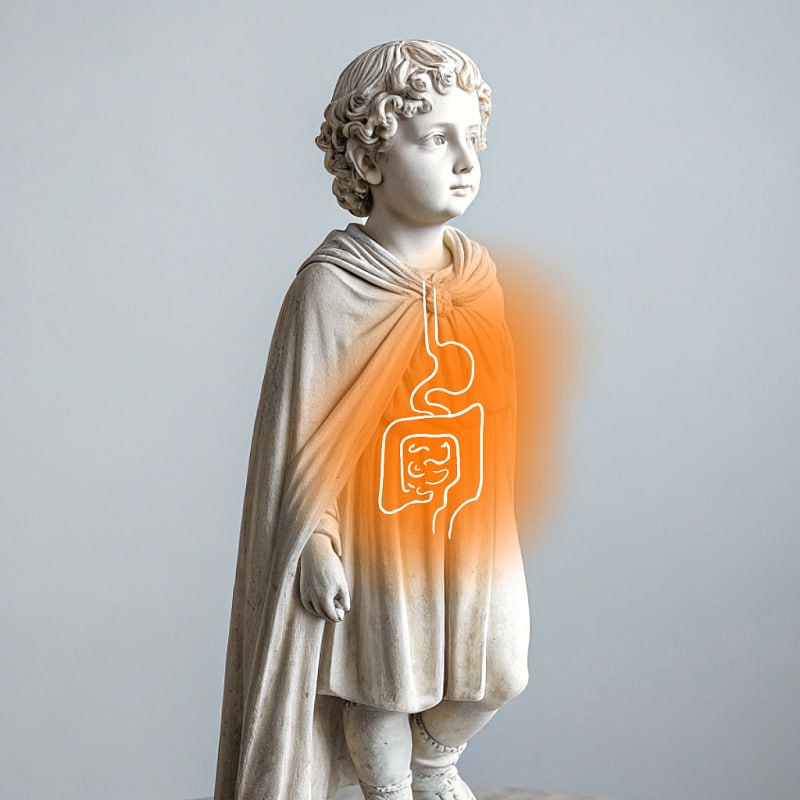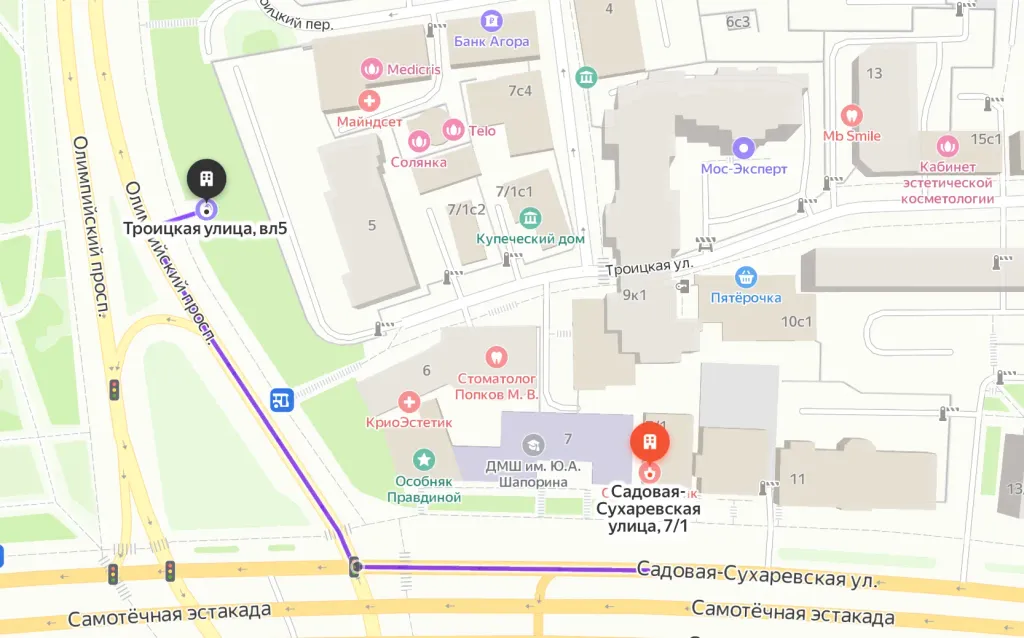Pediatric colonoscopy
Colonoscopy is an examination which involves using special equipment to visually inspect the inner surface of the large intestine and the terminal ileum. The procedure helps identify inflammation, ulcers, polyps, and other changes that may cause abdominal pain, blood in the stool, constipation, or diarrhea. If the child has a polyp, a biopsy will be performed for histological examination. Then, the need for endoscopic removal will be determined.

The child and parents must meet with an anesthesiologist and a pediatrician 72 hours before the colonoscopy. They will examine the child, provide recommendations, and answer any questions. Three to five days before the examination, the child will be put on a special low-residue diet that excludes plant fiber. Before the colonoscopy, the intestines must be cleansed with medication or an enema, depending on the child's age and medical recommendation. Following the provided instructions exactly is crucial for an informative examination that does not require a repeat procedure.
Colonoscopy is performed under sedation. The child falls asleep under medical supervision and feels no pain. The specialist inserts a thin, flexible endoscope through the rectum and carefully examines the entire colon up to the point where it transitions into the small intestine. In some cases, a biopsy may be performed, which involves taking a small sample of tissue (mucous membrane) for examination under a microscope. The entire procedure takes about 30-40 minutes.
We use HD video colonoscopes with enhanced imaging features that give us the clearest and most detailed picture possible. These endoscopes can show even small changes in the lining of the intestine.
The child remains in a comfortable ward under medical supervision for about 30-40 minutes after the colonoscopy. Once fully awake, the child receives an examination and recommendations regarding nutrition and daily routine. Rest and fresh air are recommended on the day of the examination, and active games and sports should be avoided. The child can usually return to their normal routine the following day.
Benefits
Safety
Highly qualified specialists supervise the entire examination and constantly monitor the child's condition.
Accuracy
The procedure can help detect even small changes in the mucous membrane and, if needed, take a tissue sample for histological examination.
Minimal intervention
The procedure is performed through natural pathways, and doesn't require incisions or a long recovery.
Comfort
Colonoscopy is performed while the child is asleep, they feel no pain or stress.
Specialists
Find a SpecialistIndications and contraindications
Indications
Suspicion of colon polyposis with a hereditary predisposition
Long-term constipation or diarrhea
Blood in the stool
Abdominal pain of unknown origin
Сontraindications
Serious mental or behavioral disorders that interfere with the procedure
Severe blood clotting disorders that cannot be corrected
Unstable hemodynamics
Severe cardiovascular or respiratory failure
Acute inflammatory diseases of the abdominal cavity (e.g., peritonitis)
Expected effect
Polyp detection and removal
This procedure can help detect polyps in the colon, take a tissue sample for histological examination, and, based on the results, decide if they need to be removed. Timely diagnosis and treatment can help avoid serious diseases in the future.
Improved well-being
After determining the causes of the child's complaints during a colonoscopy, the specialist prescribes the correct treatment. This treatment significantly improves the baby's condition, eliminating symptoms such as abdominal pain and stool disorders.
Improved well-being
After determining the causes of the child's complaints during a colonoscopy, the specialist prescribes the correct treatment. This treatment significantly improves the baby's condition, eliminating symptoms such as abdominal pain and stool disorders.
Precise symptom diagnostics
Colonoscopy can help identify what causes symptoms such as chronic abdominal pain, blood in the stool, prolonged constipation, or diarrhea. This can help choose the most effective treatment.
Similar referral activities
Pediatric gastric and colonic mucosal biopsy
Endoscopic biopsy in children is a painless method of obtaining a small sample of tissue during gastroscopy or colonoscopy. The procedure helps identify the causes of chronic diseases, inflammation, digestive disorders, and other pathologies.
Pediatric gastroscopy
Gastroscopy is a safe procedure during which the esophagus, stomach, and initial section of the small intestine are carefully examined using a thin, flexible device called a gastroscope.
How to reach
How to get
From the Belorusskaya metro station of the Zamoskvoretskaya line - exit 4 After exiting the subway, walk through the pedestrian tunnel and climb the stairs. Move towards the railway tracks, go down the stairs immediately after them and walk along the house, then turn right onto 1st Yamskoye Pole Street. At the turn to 3rd Yamsky Pole Street, cross the road at the pedestrian crossing and continue along 1st Yamsky Field Street, after a few buildings on the left you will see Olympus Clinic MARS.
Travel time
9 minutes
Landmark
Olympus Clinic MARS sign
How to get
From the Belorusskaya metro station of the Ring line - exit 2. After exiting the subway, turn left and walk to the pedestrian crossing. Cross the road through two pedestrian crossings and move along the Tverskoy overpass. Go down the stairs immediately after the railway tracks, walk along the house, then turn right onto 1st Yamskoye Pole Street. At the turn to 3rd Yamsky Pole Street, cross the road at the pedestrian crossing and continue along 1st Yamsky Field Street, after a few buildings on the left you will see Olympus Clinic MARS
Travel time
11 minutes
Landmark
Olympus Clinic MARS sign
From the metro station "Tsvetnoy Bulvar"
1 exit to the city, then left to the Garden Ring, at the crossing to the right, crossing the boulevard, one more crossing and at the traffic light to the left. The Olymp Clinic building is located overlooking the Garden Ring to the right of the crossing. Travel time is approximately 9 minutes. Landmark - sign Olymp Clini
From the metro station "Sukharevskaya"
Exit 3 from the metro and 640 meters straight ahead, the clinic will be on the right. Landmark - sign Olymp Clinic
Parking lot map
Exit 3 from the metro and 640 meters straight ahead, the clinic will be on the right. Landmark - sign Olymp Clinic

From Sokol metro station
The last car from the center: follow the signs for Exit 5. From the glass doors to the right and go to the end of the passage. Exit to the city by the steps to the left. After exiting the crossing to the street, go straight along Leningradsky Prospekt to the intersection with Chapaevsky Lane. Next, turn right (onto Chapaevsky Lane) and walk to the Triumph Palace residential complex. Entrance to the territory: through checkpoint No. 1, opposite the Vkusville store, you will need to present your passport. After passing through the checkpoint, go up the stairs to the fountain, opposite it you will see our clinic.
Travel time
10-12 minutes
From the Airport metro station
The first car from the center: follow the Exit 2-3 signs. Turn left out of the glass doors and walk to the end of the passage. After exiting the crossing to the street, go straight along Leningradsky Prospekt to the intersection with Chapaevsky Lane. Next, turn left (onto Chapaevsky Lane) and walk to the Triumph Palace residential complex. Entrance to the territory: through checkpoint No. 1, opposite the Vkusville store, you will need to present your passport. After passing through the checkpoint, go up the stairs to the fountain, opposite it you will see our clinic.
Travel time
12-15 minutes
How to get
Entry to the territory is prohibited, but there are free city parking lots around the Triumph Palace residential complex, where you can easily find a place for your car. Free parking area:



